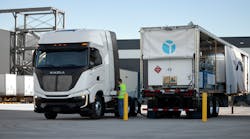The time it takes to refuel, the location of fueling sites and the range a fuel provides can weigh heavily on those who are looking to get the most productivity from their vehicle fleets. For fleets looking to increase their range and utilize an alternative fuel, bi-fuel systems may be the answer.
“Bi-fuel vehicles are capable of operating on two fuels independently and provide the driver with flexibility for their primary fuel choice based on fuel availability and pricing,” explains Mike Taylor, director of autogas business development for the Propane Education & Research Council (PERC) – a leader in propane safety, training programs and products (www.propanecouncil.org).
Bi-fuel systems predominantly operate with propane autogas as the primary fuel and gasoline as the secondary fuel. However, bi-fuel systems may utilize compressed natural gas (CNG) and gasoline or diesel, too.
The most common types of bi-fuel systems used today are direct injection (DI) systems and electronic fuel injection (EFI) systems – also referred to as multi-port liquid injection systems.
According to Taylor: “EFI systems deliver propane autogas directly into each cylinder’s intake port, which improves breathing efficiency and thereby leads to overall improved engine performance.”
A DI fuel system, which PERC is helping develop and certify, is capable of delivering propane directly into the engine’s cylinders for enhanced combustion and performance. This, Taylor says, is comparable to gasoline engines.
“One of the greatest enhancements in propane autogas DI systems is the use of original OEM fuel system components,” he notes, referring to injectors, fuel rails and other related parts. “These reduce redundancy and complexity while improving maintenance capabilities.”
“The fuel selection is done by the use of a solenoid operated switching block to allow gasoline or propane to reach the injector,” adds Calvin Thorn, director of warranty and customer service for CleanFUEL USA (www.cleanfuelusa.com) – a global manufacturer of certified and approved alternative fuel equipment for propane autogas.
WHY BI-FUEL?
Perhaps the most attractive reason for utilizing bi-fuels systems in a fleet is the extended intervals between refueling. Long-run or high-mileage fleets that require frequent refueling can give their drivers the ability to operate on propane and switch to gasoline if necessary.
“It eliminates the range anxiety,” says Darren Engle, director of government relations for Blue Star Gas (www.bluestargas.com), a third-generation family-owned propane company that services California, Oregon, Washington, Arizona and Utah with a heavy focus on propane autogas.
Engle says the versatility provided by having two fuel systems on board is a benefit, not only while a driver is operating the vehicle, but also because it safeguards businesses from fluctuating fuel prices. “It’s always giving you the ability to run the least expensive fuel for your business operation.”
Additionally, PERC’s Taylor says drivers appreciate the quick, clean refueling process associated with autogas. “Drivers don’t smell like gasoline or diesel after refueling is complete.”
In addition to fuel savings, fleets also can benefit from:
- Maintenance and operation savings.
- Quieter operation.
- Eliminated or reduced EPA hazmat concerns.
- Reduced emissions when compared to gasoline.
One common challenge for a fleet operating vehicles with bi-fuel system is enforcing drivers to use the alternative fuel rather than traditional gasoline or diesel, which they are more accustomed to.
“The question always becomes, when you give a driver an option of using fuel they’re comfortable with, will they use that alternative fuel? You have to have the right policies and procedures in place to make sure the drivers are using the propane or natural gas as much as possible,” states Todd Mouw, vice president of sales and marketing at Roush CleanTech (www.roushcleantech.com) – a producer of alternative fuel powered products, including alternative fuel systems for light and medium duty Ford trucks and vans.
“Fleets or drivers who choose to operate on gasoline, rather than propane autogas 100 percent of the time, experience a premature ceiling on the fuel savings and emissions reductions that can be realized,” adds Taylor of PERC.
If a vehicle is driven outside of its home base and requires maintenances for the propane system, CleanFUEL USA’s Thorn says finding qualified technicians may be difficult. That said, a driver could use gasoline to return the vehicle back to its usual service facility.
INSTALLATION
Light duty cars, pickups, SUVs and vans can utilize bi-fuel systems to perform a number of applications and vocations. But, similar to spec’ing conventional fuel systems, fleets should consider all factors before making a decision regarding bi-fueled vehicles.
“To determine if a fleet should proceed with an alternate fuel conversion, a cost saving analysis should be done on each vehicle to show what cost savings is seen within the useful life of the vehicle,” recommends Thorn of CleanFUEL USA.
“There is a place for all the different technologies, depending on the application, the duty cycle and how much range the customer would need,” adds Roush CleanTech’s Mouw. “It really goes back to understanding how the vehicle is used and for what application.”
Engle of Blue Star Gas explains there are OEM bi-fuel systems that can go directly onto the manufacturer’s ECU, and aftermarket kits that use a secondary computer to gather fuel trim information from the OEM computer in order to operate the propane system.
The standard or optional gaseous prep options that OEMs have begun providing for many vehicles are installed by qualified vehicle modifiers (QVM) or certified conversion centers. “QVMs and certified conversion centers are staffed with qualified technicians to ensure customers receive state-of-the-art installations and performance comparable to conventional fueled vehicles,” says PERC’s Taylor.
Though the Magnusson Moss Act of 1975 prohibits vehicle manufacturers from voiding a vehicle’s warranty policies and coverage if aftermarket parts are installed on a vehicle, Taylor says if a malfunction occurs, and it is proven that the aftermarket systems or parts caused the failure, then an OEM can deny warranty claims and coverage.
“PERC works very closely with its aftermarket supplier partners to ensure only certified systems are sold into the marketplace and each partner has a certified and qualified network to support its propane autogas vehicle customers,” he says. “This includes warranty policies that protect customers in the unlikely event of a system malfunction.”
Once a vehicle is converted to bi-fuel, resale value can be affected. Thorn of CleanFUEL USA explains that if a dealer has concerns about finding a buyer for the bi-fuel vehicle, he or she might not offer the best trade-in price. But, “if the owner selling the vehicle has ties within the LPG/CNG industry and finds a buyer wanting a bi-fuel system, a slightly higher price may be asked.”
While resale values can vary, Taylor says other total cost of ownership (TCO) savings can be provided by propane autogas vehicles. “Once total savings are quantified after the vehicle is sold, fleets are firmly in the black.”
Additionally, both Taylor and Engle note that with bi-fuel systems, the alternative fueling equipment can be removed and the asset can be sold as a gasoline-powered vehicle.
BI-FUEL REQUIREMENTS
Other than the minor differences in system components, maintenance for a propane autogas fuel system is very similar to a gasoline engine.
Before converting a vehicle though, Engle of Blue Star Gas emphasizes complete preventive maintenance. “If the vehicle had challenges running on gasoline, putting another fuel system on board is not going to make the vehicle run perfectly. You’re still going to have challenges with the engine.”
Because there are two fuel systems on the vehicle, there are multiple filters, injectors and other components. Those need to be serviced at approximately the same intervals as their gasoline counterparts.
This may mean fleets that service their own vehicles will need to stock additional replacement parts.
HAVE ANOTHER LOOK
Bi-fuel systems, much like many alternative fuel solutions, have evolved over time. Bi-fuel vehicles have become more efficient, so Engle of Blue Star Gas recommends learning more about bi-fuel options – even if a fleet previously has done research.
“Understanding the fuels and how they best fit your fleet is the first thing that needs to be done,” he says, adding a fleet shouldn’t focus on one option because it may benefit from multiple alternative fuel solutions. “Right along with that is an understanding that technology is not what it was five years ago; it’s not what it was 10 years ago; it’s not what it was 20 years ago.
“The alternative fuel systems today are not science projects. They absolutely work,” Engle continues. “They are readily deployed across the county. Fleets are using them and are very satisfied with their use.”



